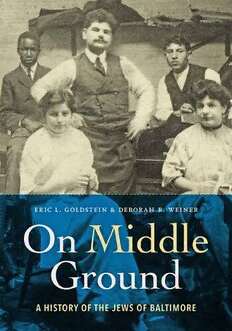
On Middle Ground: A History of the Jews of Baltimore PDF
Preview On Middle Ground: A History of the Jews of Baltimore
On Middle Ground On Middle Ground A History of the Jews of Baltimore Eric L. GoLdstEin and dEborah r. WEinEr Published in Cooperation with the Jewish Museum of Maryland Johns Hopkins University Press baLtimorE © 2018 Johns Hopkins University Press All rights reserved. Published 2018 Printed in the United States of America on acid-free paper 2 4 6 8 9 7 5 3 1 Johns Hopkins University Press 2715 North Charles Street Baltimore, Maryland 21218-4363 www.press.jhu.edu Library of Congress Cataloging-in-Publication Data Names: Goldstein, Eric L., author. | Weiner, Deborah R., author. Title: On middle ground : a history of the Jews of Baltimore / Eric L. Goldstein and Deborah R. Weiner. Description: Baltimore : Johns Hopkins University Press, [2018] | Includes bibliographical references and index. Identifiers: LCCN 2017018080 | ISBN 9781421424521 (hardcover : alk. paper) | ISBN 9781421424538 (electronic) | ISBN 1421424525 (hardcover : alk. paper) | ISBN 1421424533 (electronic) Subjects: LCSH: Jews—Maryland—Baltimore—History. | Baltimore (Md.)—Ethnic relations. Classification: LCC F189.B19 J53 2018 | DDC 975.2/6004924—dc23 LC record available at https://lccn.loc.gov/2017018080 A catalog record for this book is available from the British Library. Frontispiece: The bar mitzvah of Louis Stein (detail), 1908. Jewish Museum of Maryland. Special discounts are available for bulk purchases of this book. For more information, please contact Special Sales at 410-516-6936 or [email protected]. Johns Hopkins University Press uses environmentally friendly book materials, including recycled text paper that is composed of at least 30 percent post-consumer waste, whenever possible. To two products of Jewish East Baltimore: Albert Goldstein (1911–1986) and Sylvia Feldman Goldstein (1912–2008) May their memory be for a blessing This page intentionally left blank Contents Acknowledgments ix Introduction 1 One. Baltimore’s First Jews 17 Two. A “City and Mother in Israel” 53 Three. The Great Wave Hits Baltimore 104 Four. Bawlmer Jews: The Interwar Years 179 Five. From Baltimore to Pikesville 244 Epilogue. The Challenges of a New Century 301 Notes 321 Index 369 This page intentionally left blank Acknowledgments During the many years we have each been researching and writing about the history of Baltimore Jews, we have relied on the support and assistance of numerous indi- viduals and institutions. First and foremost, we wish to thank the Jewish Museum of Maryland (JMM), which has served as the home base for this project. Former execu- tive director Avi Y. Decter helped us envision the book and harnessed the resources that made it possible. Deborah Cardin, our liaison with the museum, smoothed the way through the many stages of our work. Joanna Church carried out the massive task of assembling images and obtaining the necessary permissions. Thanks also to current executive director Marvin Pinkert, who joined the JMM after the project was under way. The following donors provided generous funding to the JMM to underwrite the publication of this book: the Richard and Rosalee C. Davison Foundation, Willard and Lillian Hackerman, the Whiting-Turner Contracting Company, the Leonard and Helen R. Stulman Charitable Foundation, and the Joseph and Harvey Meyer- hoff Family Charitable Funds. Additional financial support for the project was pro- vided by the Southern Jewish Historical Society and the Tam Institute for Jewish Studies at Emory University. We owe a particular debt of gratitude to Gilbert Sandler, the keeper of the mem- ory of Baltimore Jewry. Gil has inspired us with his keen eye for history and his gift for storytelling. We have learned much from his many publications and appreciate the enthusiastic support he has given to our work. The book also owes much to former JMM leaders who pioneered in exploring Baltimore Jewish history and built the collections on which our research is based. We particularly wish to recognize the late Isaac M. Fein, a founder of the Jewish Historical Society of Maryland (the JMM’s predecessor) and author of an important institutional history of Baltimore Jews, The Making of an American Jewish Community (1971); and Bernard Fishman, the JMM’s first professional director, who transformed it into one of the nation’s leading Jewish history museums and archives. We also must acknowledge the late ix
